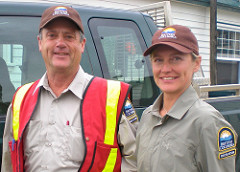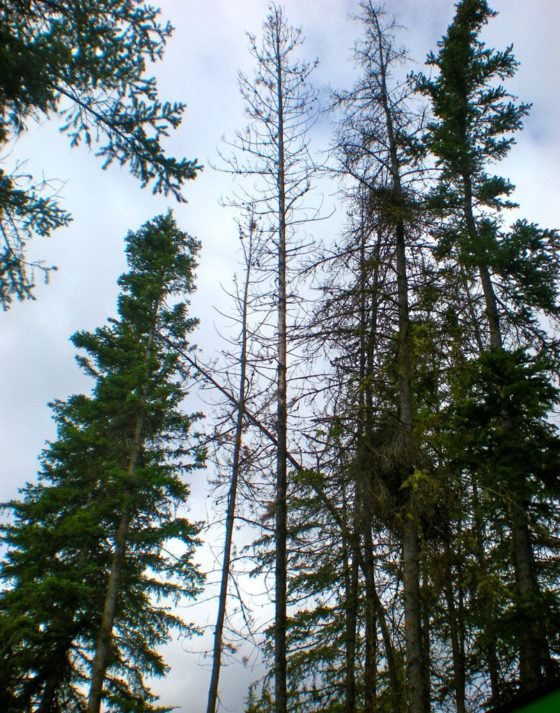Due to the mountain pine beetle invasion, thousands of B.C. trees have damage that makes them dangerous. For safety’s sake, these trees are being removed.

Recreation officer Doug Harris and recreation technician Michelle Wiebe in 100 Mile House, B.C., August 2010
If a tree falls in the forest – better that it’s not beside someone’s tent or picnic table.
Thanks to the mountain pine beetle invasion, thousands of trees in B.C. are designated as “danger trees” because they have severe lean, root damage, or rotten branches that make them likely to fall. For safety’s sake, these trees are being removed from within striking distance of campsites, picnic tables, outhouses, and parking lots.
“Just because it’s dead, doesn’t make it a danger tree because it’s still got good roots,” said recreation officer Doug Harris, who has overseen the removal of 14,000 trees since 2003 from recreation sites in his region.
I met Doug and his colleague Michelle Wiebe recently at a government office in 100 Mile House when I was camping in the area. Doug works for the B.C Ministry of Tourism, Culture and the Arts, looking after 75 recreation sites (formerly known as “forestry sites”) in the Chilcotin / 100 Mile House region. Michelle is a recreation technician based out of Kamloops.

The trees in the centre are dead, but not necessarily dangerous. This photo was taken on private property in the Cariboo. Photo credit: Susan Main
“More than 30,000 people use the sites in my area alone and I am proud to say that none of the sites had to be closed – nor were there any injuries or damages due to mountain pine beetle/danger trees,” Doug said.
Doug and his colleagues assess trees and preserve important wildlife trees that, though dead, are home to birds and small animals. Danger trees are marked “D” for danger and cut down by certified falling contractors. Crews dispose of the tops and limbs and buck the wood into firewood lengths, as budget allows.
In 2007, the Canadian government offered funding for removing danger trees – with good timing for local logging workers affected by the economic downturn. Mills were closing and they were being laid off.
“The funding sources put some of these guys back to work,” Doug said. “If we didn’t get the federal money, we would have closed the sites. We would just say ‘it’s too dangerous,’ and so fortunately we never had to close any.”



Pingback: Hazards of working near burnt trees after wildfires | AgSafe